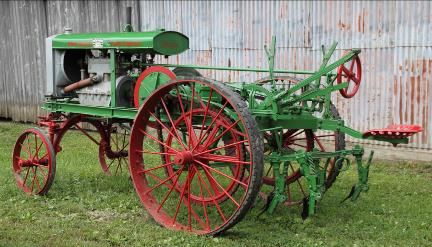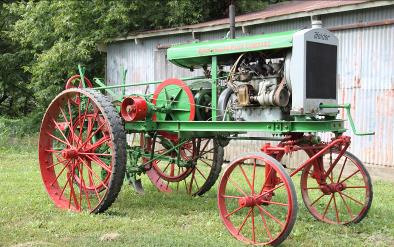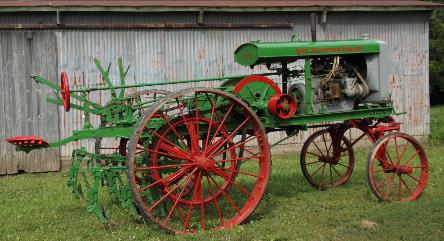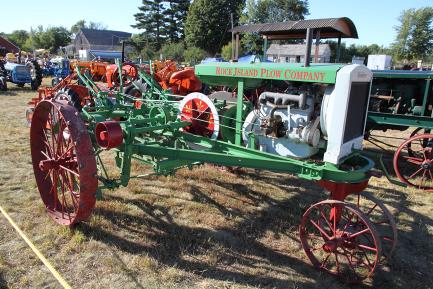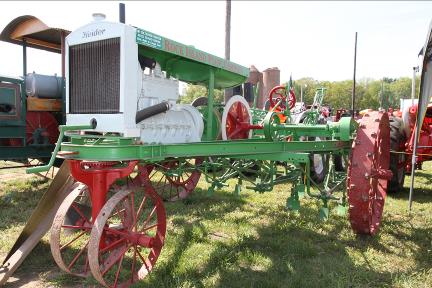




Tractor Summary |
|
M, M1 & M2 1915-1925 |
|
HP 5-10 |


|
Copy write 2011, 2012, 2013 not for republication or sale without express written consent. All images are the property of their respective owners and are not to be reused without their express permission. |
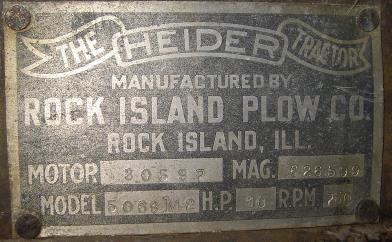
|
· Weight: ~2600 lbs · Engine: LeRoi 2c 4 cylinder 3 1/8 x 4 1/2 · Mag: Dixie · Carb: Kingston L2 · Serial Numbers: M M1 & M2 |
|
The Heider Motor Cultivator was Rock Islands entry into the small field of motor cultivator tractors with such names as Emerson Brantingham and Avery. Companies like John Deere, J.I. Case and IHC also experimented with this concept, but they never really entered the market. Although a good concept on paper starting even around 1910, their limited use and light construction limited their utility and the introduction of the Farmall finally ended the idea of a dedicated cultivator tractor.
Although advertised as a light all-purpose tractor, the Heider cultivator tractor was not as solidly built as such tractors as the Moline Universal and Allis Chalmers 6-12 (which along with the Indiana and IHC motor cultivator were some of the many tractors to use the LeRoi 2c). The M/M1 especially would prove to be fairly unsturdy and it is unlikely too many farmers equipped it beyond the cultivator gangs. The M2 however with its narrower, more rigid frame did see use for other tasks including plowing.
Capable of mounting 4-, 6-, and 8- shovel gangs, a 16” 1- bottom plow, or 6 or 8 disk gang; the 5-10 was supposed to be a replacement for a range of horse drawn implements. Unfortunately, it was unable to plant and so could not entirely replace a gang of horses. The engine and radiator were detachable with 6 bolts according to literature to be able to transport the engine as a portable 10hp power unit (Although this is not an entirely easy task).
Three models were available, the narrow front 2-row M and its replacement M1 and the wide front single row M2. Although a belt HP of 10 is agreed on, there is conflict about the drawbar rating. The literature I have all indicates a drawbar HP rating of 5. However, a 6 HP drawbar rating is often given by authors. Erb in “Full Steam Ahead” claims the M2 as 5-10 and the two row model as a 6-10. Contrary to some authors, the M2 was the successor to the M. In earlier literature, the two row M is listed, soon followed by the designation M1 and M2. Later in advertising, the M1 mostly disappears and is almost strictly advertising for the 1-row M2.
Although I have lumped the M and M1 together in the past, it now seems likely they were actually considered two separate models. The M was the earliest version, and featured a direct gear drive and large gear box. The M1 used a chain drive and featured a smaller gear box, the gear box farther forward and a different layout for the hood supports.
An article in Feb 1920 in Automotive Industries may possibly give a clue as well. The article states “Although it is making its initial appearance at the show this cultivator has been in use for about 2 years as an experimental proposition”. This is actually supported somewhat by the lack of motor cultivator references in Rock Island literature prior to 1920, for instance it does not appear at all in the 1918 full catalog. Furthermore, the two patents filed in regards to the motor cultivator occurred at different times. Patent #1529023 was filed in December 1918 and covered the M (M1) steering , front wheel and cultivator gang mechanisms. The second, patent #1546446, filed April 1922 was for the concept of having the engine as a removable power unit. Interestingly, the motor cultivator used a yoke mechanism to move the disk forward and back, instead of moving the entire motor. Oddly enough, this mechanism was not adapted into later drawings for the Heider 18-35.
The Motor Cultivator was advertised as being exceptionally short turn, featuring a design that turned the front wheels and gang at the same time and on the M/1M1 was especially designed for a short turn radius. A brake was equipped on each differential allowing the drive wheels to be slowed or stopped independently, but the positioning meant in practice the brakes were virtually useless. Speed is very fast, and on the M2, the chain steering does not permit precise steering fine adjustments when cultivating were made with the feet.
Operating the M/M1 was tricky with 6 speeds forward and back, two brake pedals, left and right foot controls for shifting the gangs left and right, two lever banks of two levers each (raise and lower each gang and on one lever raise and lower both gangs together). Steering on the M1 was very short and fast with the front wheels being able to turn almost around. At over 8 feet wide for a wheelbase it is stable, but light construction made it seem fragile. The M2 on the other hand, was a much more compact design, resulting in a much more rigid frame. Having only one gang to control resulted in a much simpler design and it could be run on the fly without stopping at the end of each row to raise and lower the gangs. Advertising shows the M2 doing multiple tasks such as plowing and disking.
Despite the advertising that it could replace the horse and versatility, no planter attachment meant the horse couldn’t be replaced entirely, and in the end the motor cultivator proved to be too expensive for its target market. Its light design also led to the tractor wearing out faster then a heavier tractor, with many lasting only a couple of years according to reports. In the end, the line was dropped around 1925 although it remained in advertising until at least 1928-29.
|
|
Cultivating with the M2 at Geneseo AE&TA Working Farm Show |
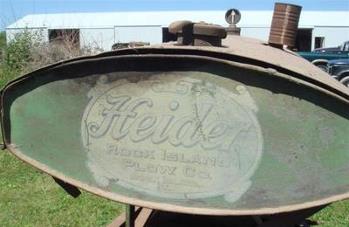
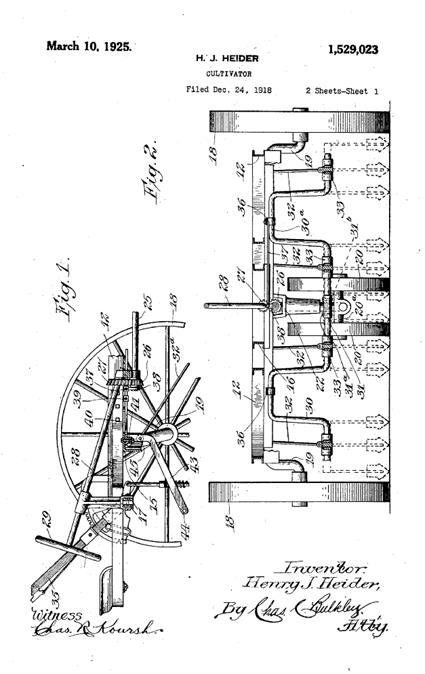
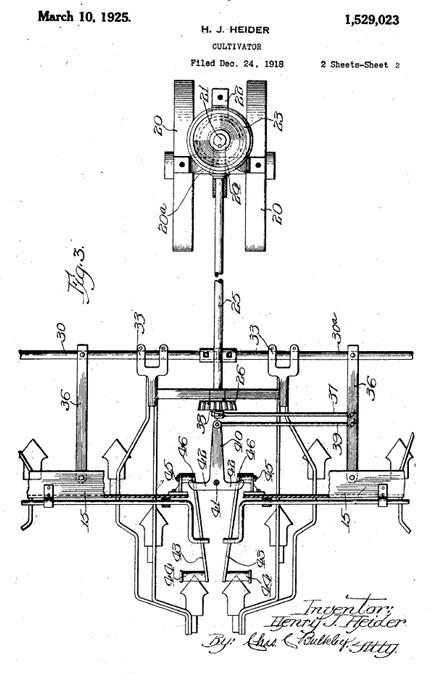
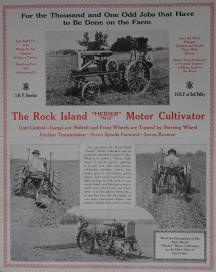
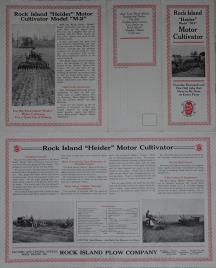

|
Above: Heider M advertisement |

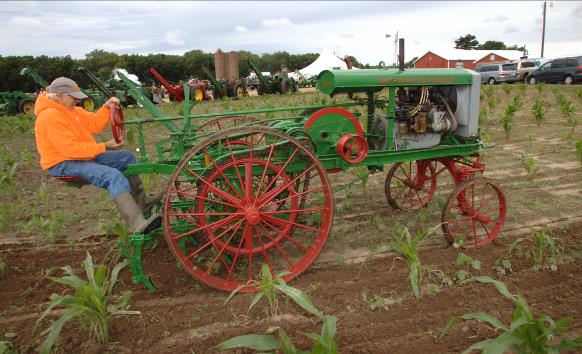

|
Left: Cultivating at Geneseo IL AE&TA fall show 2014
Right: Original badge for gas tank, appears to be the same as fender badge on other Heider models.
Below: Heider M1 and two M2’s at Geneseo. The M2 with the plow is original condition and still shows some original badging and used to show pin striping. The plow is original. The current owners dad purchased it out of the onion fields in Bettendorf IA in the 1950’s. |
